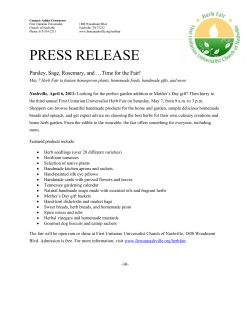
Medicinal Quality
Medicinal Quality Banxia Pinellia ternata Heiner Fruehauf Banxia is one of the most versatile herbs in the Chinese materia medica. Most classical texts consider it to be the primary herb for transforming phlegm and descending counterflow. Banxia’s traditional indications of coughing and vomiting, however, are best understood as symbolic clues that point to the herb’s clinical potential in modern times, offering unique solutions for common problems such as insomnia, high cholesterol, high blood pressure, cancer, and brain chemistry (seratonin/dopamine) dysregulation. Classical commentators have offered the following opinions about the range of organ systems that Banxia affects or “enters”: • Spleen/Stomach (poor appetite, diaphragm congestion, belching, hick-upping, gurgling sounds in intestines) • Lung (phlegm, coughing) • Gallbladder (nausea, vomiting) • Heart (insomnia, mental problems) Traditional Terroir Considerations (didao yaocai) Genuine Banxia used to grow wild in most areas of China. 1,500-2,000 years ago, most classical texts specified the classicalchinesemedicine.org classicalpearls.org © 2014 heiner fruehauf page 1 banxia: pinellia ternata traditional growing region of premium Banxia to be in today’s Shaanxi Province. Starting with the Tang dynasty, scholar physicians began to favor Banxia from Shandong Province. During the last 600 years the regions of Jingzhou and Qianjiang in Hubei Province as well as Nanchong in Sichuan Province have been considered the most suitable growing areas for premium quality Banxia. One of the reasons for this movement from West to East and back West again could be that Banxia prefers neutral to acidic soils (pH 6-7), and gradually shifting climate patterns may have shifted the soil composition in traditional Banxia growing areas. Due to the wide usage of the herb in China and Japan, genuine Banxia has been in short supply since the Song dynasty. At least two 11th century herbal primers point out that other species such as Shui Banxia (Typhonium flagelliforme), Huzhang (Pinellia pedatisecta) and Shanzhu Banxia (Arisaema yunnanense) have been used to replace or dilute the genuine product. While these medicinals still have the capacity to transform phlegm, they do not possess the crucial function of reversing symptoms of qi counterflow that is alluded to in the herb’s name: Banxia—Half Summer; the time around the summer solstice when the Banxia tuber can first be harvested and when nature’s qi is beginning to move downwards and inwards. In modern times, genuine Banxia is even harder to find on the Chinese market, commanding prices up to 10 times that of common replacement materials. Ming dynasty times. Classical Pearls’ Banxia is cultivated by Dong Yanni, a young female entrepreneur with a moving life story and an iron determination to revive traditional growing techniques. During the last decade, she has been able to perfect her grandfather’s technique of growing the highest quality Banxia sustainably without pesticides or artificial fertilizers. Traditional Processing (paozhi) Unprocessed Banxia has the potential to irritate the throat. Classical texts therefore specify that the herb should be rinsed 7-10 times to remove the slimy irritant covering the surface of the tuber. Later generations developed additional processing techniques to further control the intense quality of the raw herb, most prominently Qing Banxia (alum processed), Jiang Banxia (ginger and alum processed) and Fa Banxia (licorice and lime processed). In unprocessed form, Banxia is slightly cooling and has the ability to dissolve nodules and tumors. In processed form, Banxia turns into a more warming herb with enhanced ability to transform phlegm. Classical Pearls includes various forms of processed Banxia in its formulas. For the needs of single herb customers, we offer both unprocessed Banxia as utilized in the Shanghan lun (thoroughly rinsed according to traditional specifications) and traditionally prepared Fa Banxia (increasing the herb’s capacity to transform damp and rebuild Spleen function). Classical Pearls is proud to offer genuine Han Banxia/ Dizhu Banxia (Pinellia ternata) from the unspoiled countryside of Qianjiang in Hubei Province, a didao location for Banxia where fertile soils and ample rain fall have provided ideal growing conditions for the plant since classicalchinesemedicine.org classicalpearls.org © 2014 heiner fruehauf page 2
© Copyright 2025





















